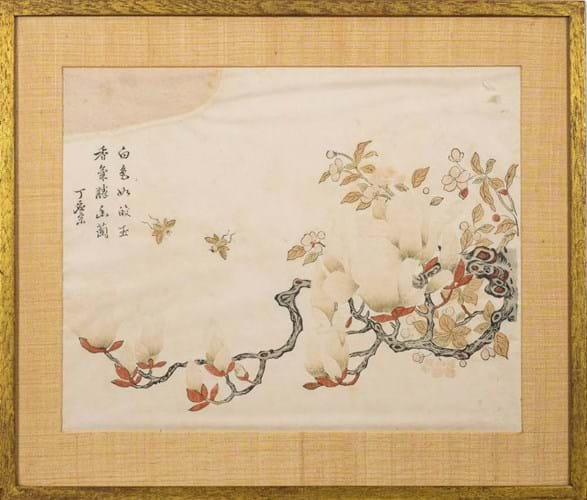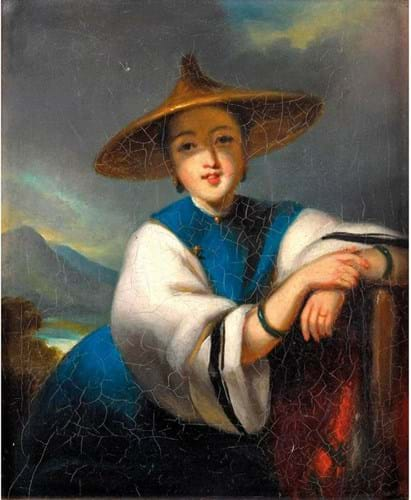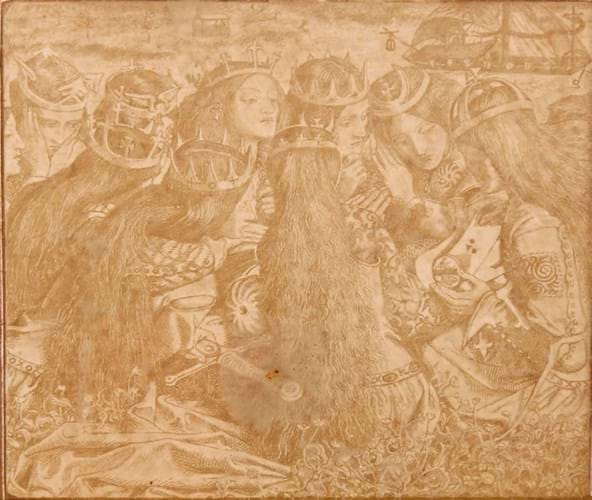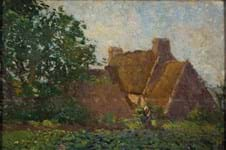
Magnolia and Bees, a woodblock print catalogued as ‘after’ Ding Yingzong, £25,000 at Bearnes Hampton & Littlewood.
Recently several high prices for such works were registered for particular lots in the regions. These included a couple of pictures with a distinct Chinese flavour. Most notably, a woodblock print depicting a magnolia branch and bees, estimated at just £60-80, took an eye-catching £25,000 at Exeter saleroom Bearnes Hampton & Littlewood (25% buyer’s premium) on January 17.
It was catalogued as ‘after Ding Yingzong (fl. c.1700-50)’, an artist (or possibly a workshop of artists) who worked in Suzhou, Jiangsu province, in the second quarter of the 18th century. At the time, new types of woodblock print were being created to appeal to urban Chinese audiences.
Ding Yingzong’s work recalls contemporaneous Qing paintings. They aim to capture the naturalism of the magnolia blossoms through subtle colour gradations, hand-coloured wash, the limited use of outlines and embossing. The inscribed couplet compares their colour to glowing jade.
A similar print in the British Museum collection is dated to c.1735-50. It was bequeathed by celebrated Irish physician, naturalist and collector Sir Hans Sloane (1660-1753) and is currently on loan to the Met in New York.
Woodblock prints from this period are rare on the market outside mainland China. However, a price parallel can be drawn between this work in Exeter and four ink and colour-on-paper prints sold together for £85,000 as part of the Fine Asian & Islamic Works of Art sale at Lyon & Turnbull on November 4. They were by the artist or workshop named Ding Liangxian, who was also working in Suzhou in the period c.1735-50.
The print at BHL measured 11 x 13½in (28 x 35cm). With bidders presumably comparing it with the British Museum example, it drew strong interest against its modest estimate. After a prolonged competition it was knocked down to an online buyer.
Chinnery link

A Chinese sampan girl of Macao, a painting attributed to George Chinnery that sold for £10,000 at Lawrences of Crewkerne.
Meanwhile, a bidding battle took place on January 18 at Lawrences (25% buyer’s premium) of Crewkerne for a portrait of a Chinese girl which was attributed to George Chinnery (1774-1852).
The 11in x 9in (28 x 23cm) oil on canvas came to auction from a private collection in Nottinghamshire. Although the collection had no particular emphasis on China Trade works, Lawrences’ picture specialist Richard Kay said the late owner had “a discerning eye with an eagerness for art that spanned four centuries”.
Chinnery left Britain in 1802 at the age of 28, spending two decades in India and then moving to Macao in 1825 in order to seek refuge from his creditors (he was heavily in debt). The artist remained on the south China coast for the rest of his life (he is buried in Macao’s protestant cemetery) and produced numerous scenes of the local topography, sampan and junk boats as well as portraits of Hong merchants and local women.
Indeed, the style of his portraits had a strong influence on Chinese export artists, including Guan Qiaochang Lamqua (1801-60) who is credited with being the first Chinese portraitist to be exhibited in the West.
The picture in Somerset showed a finely dressed Tanka girl with a landscape to the background. It was similar to other known portraits that the artist painted in Macao. The fact that it was unsigned mattered less than the ‘signature’ features present in the work – the rapid brushwork, the pose of the sitter, the use of vermillion in the cheeks and lips. In any case, Chinnery seldom signed his works which were mostly executed rapidly and in great number.
His portraits of Tanka girls are very much of a type, depicting the sitters with a more western complexion that his Cantonese subjects, for example.
The work at Lawrences was lined, had scattered retouching and some craquelure was present across the surface. But the bidders who turned out on the day showed good confidence that the ‘attributed to’ cataloguing was correct, taking it over a £2500-3500 estimate until it sold at £10,000 to a European buyer who has business interests in Asia.
The price was not too far removed from the £13,000 for a fully ascribed painting by Chinnery of a Tanka boatwoman that sold at Bonhams in September.
Rossetti identified

King Arthur and the Weeping Queens believed to be by Dante Gabriel Rossetti, £4200 at Burstow & Hewett.
Also generating competition at Burstow & Hewett (20% buyer’s premium) in Hastings was an unattributed print which a number of parties identified as a wood engraving by Dante Gabriel Rossetti (1828-82). It was catalogued as ‘Miniature print, Medieval group study, unsigned’ and had an estimate of £50-80 on December 15.
The 3 x 4in (8 x 10cm) engraving had Rossetti’s monogram to the bottom right, however. It was produced by the artist for the illustrated edition of Tennyson poetry that was published by Edward Moxon with the input of members of the Pre-Raphaelite Brotherhood in 1857.
Variously titled Mythic Uther’s Deeply Wounded Son’ or ‘King Arthur and the Weeping Queens, this was one of two illustrations Rossetti created for the poem The Palace of Art. It illustrates the passage reading: ‘Mythic Uther’s deeply-wounded son, In some fair space of sloping greens, Lay, dozing in the vale of Avalon, And watch’d by weeping queen.’
Adopting an unusual composition, Rossetti depicted locks of woven hair and the handle of Excalibur in the foreground. In the background he included a sailing ship and a tomb with a sarcophagus ready for the king’s body.
The original drawing in the Birmingham Museum and Art Gallery shows the scene reversed – an image also known through an early photographic print that was sold at the time by Mansell’s of Oxford Street.
The engravings were printed twice: in 1857 and then posthumously in 1903. The example in Hastings, which appears to be from the original issue, drew significant interest on the day and was knocked down at £4200 after a lengthy competition.














